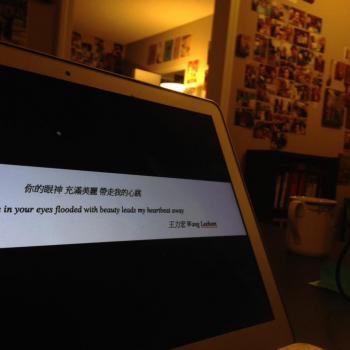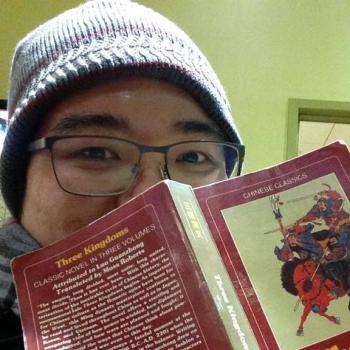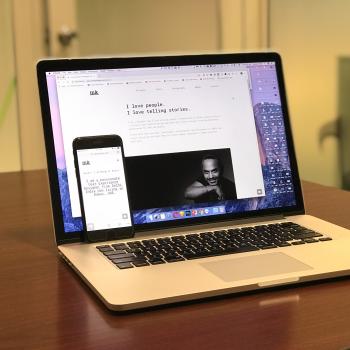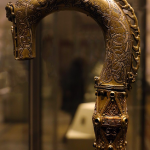![Photini and Christ at the Well The Samaritan Woman - by Ted, 1 August 2009 (3783460450_e9e7fa5b5c_b.jpg) (CC BY-SA 2.0 [https://creativecommons.org/licenses/by-sa/2.0/]), via Flickr](https://wp-media.patheos.com/blogs/sites/721/2017/03/3783460450_e9e7fa5b5c_b-1024x689.jpg)
I’ve actually been doing the history of the model minority for about four weeks in my Asian American history class, and this week was the payoff: one lecture on Monday on the origins of the model minority in the sociologist William Petersen’s 1966 New York Times Magazine piece ‘Success Story, Japanese-American Style‘ and another one on Wednesday on what my friend Soya Jung calls the #ModelMinorityMutiny. Between those two class lectures, I also gave two invited lectures called the Carl G. Westerdahl Lectures on Evangelism at North Park Theological Seminary, in which I focused on Asian American Christianity, which often centers what is called model minority evangelicalism (I criticized this centering in these lectures).
But as I wrote yesterday, I often find my own expertise wanting. Of course, the first book I read in grad school was Timothy Mitchell’s Rule of Experts; how I was trained from the beginning was that I am not becoming an expert, a technocratic know-it-all. Yet as I taught, I began realizing that there are indeed some gaps in my knowledge, as I wasn’t sure whether what I was teaching was connecting with what students actually experience in terms of the model minority myth.
Because of this, I decided to go low-key as what Paulo Freire calls a ‘teacher-student’ and to listen to my students at two events over the latter part of this week. On their invitation, I attended a joint meeting of the Asian Pacific American Coalition (APAC) with the South Asian Student Association (SASA) on Thursday night during which they discussed the model minority; over the weekend, I was also invited to give a seminar on the model minority at Asian American InterVarsity’s (AAIV) end-of-quarter retreat, Released, at the University of Illinois Urbana-Champaign, which means that I can at least say now that I have set foot before in the famous town where InterVarsity Christian Fellowship’s (IVCF) ‘Urbana conference’ has its namesake. It was in these conversations that I began to learn about what it’s like to wrestle with the model minority myth as a lived experience, which is important for me as someone who is devoting my career to busting the myth.
The truth is that in both instances, I was convinced to come for the free food. In the case of APAC/SASA, they enticed me with free samosas which they assured me were fast-friendly (somehow these non-Orthodox Asian American students all know about my fast), and I had three. As for AAIV, the team of staff assured me that my vegetarian meals would all be paid for, resulting in very creative orders at a local Korean restaurant in Urbana, as well as accommodations made at Jimmy John’s and Mandarin Wok. I have a student in my Asian American religions course who is working on ‘going out to eat’ as a (non)religious Asian American practice, so I’d better say at this point that my understanding of food here is purely nonreligious, but one of the strongest motivators for my attendance at both events nonetheless.
I also promised people at both groups that I try to keep my mouth shut, which was funny because some of the people I made these promises to are in fact students in my class who now know all too well the various convoluted ways in which I think about the history of the model minority.
My silence paid off, as I was surprised by two things. First, I was surprised by the persistence of talk about ‘Asian culture’ at both events as a culprit in producing the model minority. Certainly, I know the historiography of how Asian American communities sometimes produced model minority mythologies to fool white people into thinking that they had fully assimilated (see Henry Yu’s Thinking Orientals, Lisa Rose Mar’s Brokering Belonging, and Ellen Wu’s Color of Success), but as much of a practical joke as the model minority was supposed to be in these cases, these students saw their experience as no joke, but even as a kind of oppression. It was the AAIV Released retreat that was titled ‘Enough’ – referring to their experience of never ‘feeling enough’ as a model minority – but I heard the ‘enough’ narrative enough times at both groups to be convinced that evangelicals have no premium on this theme.
However, my second surprise is that for all of the talk of the most recent cohorts of students as a bunch of ‘social justice warriors’ with a sort of leftist fundamentalist streak in which they are supposed to double down on jargon with no substance, what I actually found was a longing for new ways of talking about such phenomena. Some students tell me that they feel jaded by what seems to be a scripted way of talking about the ‘model minority’ and resisting it, lamenting the ‘predictable conversations’ (their words, not mine) into which these discussions sometimes turn. I am learning that this current cohort of students does not want their beliefs reinforced; they want them to be challenged, broken down, and reconstructed through conversations that often feel Socratic. At APAC/SASA, I completely kept my mouth shut, then, at most using facial expressions and body language to let students know that I was listening without judgment. At my seminar at AAIV, I tried to write literally everything the students said on the whiteboard and attempted to sort through their words. Eventually, we concluded that perhaps the best way to talk about the model minority is as a kind of colonization requiring the collaboration of racialized elites, and from there, we explored the see-judge-act method in Catholic social teaching and liberation theology. In this way, I suggested to some students that the ‘Asian culture’ behind the model minority is not Asian at all; if anything, it is the aspiration to be a colonized elite, which introduces a whole new set of problems for thinking about the model minority indeed. The students seemed quite open to this way of thinking, and I am heartened by their openness to expanding their capacity to think.
As I processed these insights, I listened to two sermons by a preacher that AAIV brought to speak at the retreat: Filipino American pastor Jay Catanus, who preached through the fourth chapter of the holy Gospel according to Holy John the Theologian, Jesus’ encounter with the Samaritan woman at the well. Catanus’s homiletics were unusually refreshing; I suspect that as a PhD student at Loyola University in Christian ethics, he’s imbibed some of the Ignatian spirituality in the air there too, as his sermons simply walk us through the lived experience of the biblical situation in relation to his own life story as a Filipino missionary kid in Chicago. Focusing on images of material objects and spaces in the text – the well, the mountain, the fields, the jar – Catanus led us in what felt like a guided meditation through a direct encounter between Jesus and the Samaritans, making Christ present to us as well.
Mulling over Catanus’s meditations, I find myself thinking about the two insights I gleaned from my listening about the model minority this week. Far be it from me to portray myself as Christ listening to all these ‘Samaritan women’ – that would be offensive at so many levels – but perhaps it is fair to say that I felt like I have been eavesdropping on a conversation that perhaps my students who are tired of practicing the politics of identity are trying to have with each other as persons, and maybe even with Christ as a person. Perhaps it is thus in mikrodiakonia that makrodiakonia is done, and I am grateful to my students for letting their professor see them as persons and listen to them, because in the process, I feel like they are part of my formation into the likeness of Christ, the Person who encounters me, a sinner, at the well. As persons in dialogue, perhaps we can get to the new unfundamentalist way of talking about the model minority that will finally allow us to dismantle it.
















